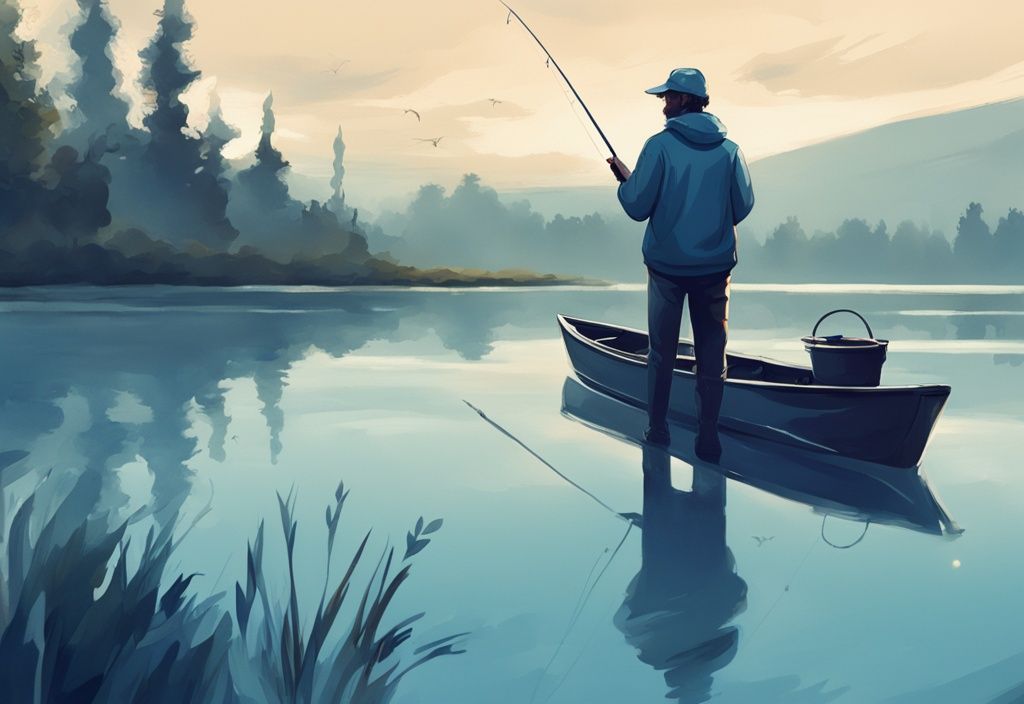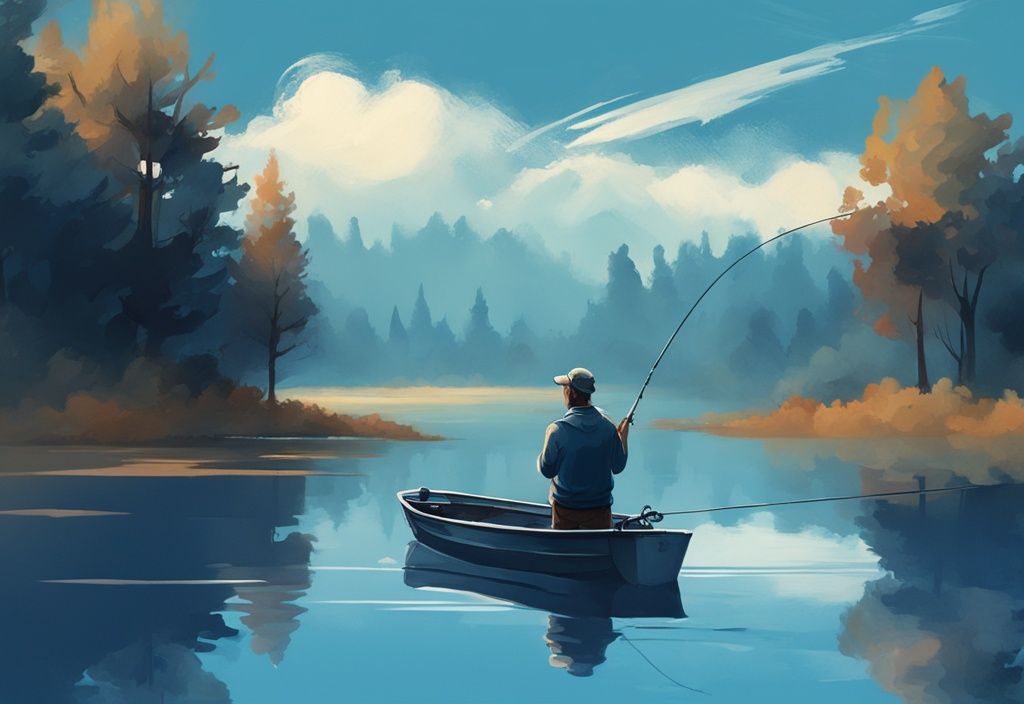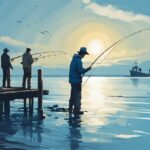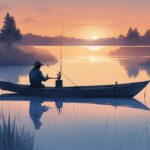Ever tried casting your line where traditional wading isn’t cutting it? Welcome to float fishing – that trusty technique boosting your odds of the perfect catch. This angling gem stands proud in its versatility, whether you’re chasing Salmon in zippy rivers or hunting Trout in serene lakes.
Curious about the ins and outs of this method? We’ve got you covered. In this guide, you’ll tap into the nuts and bolts of float fishing. From gear prep to nailing techniques, we’re sailing through it all. So, ready to ramp up your angling game and unravel the charm of float fishing?
Trust me, twenty years of casting lines tells me you’re in for a thrilling ride. Let’s dive in, shall we?
Understanding Float Fishing: Definitions and Overview
What is float fishing? Well, my friend, float fishing is a versatile technique that’s a favorite among many of us anglers. It usually involves fishing from a drift boat or raft. This method is especially prevalent in fly fishing scenarios, offering a unique approach for accessing those challenging water bodies that are otherwise difficult to reach.
Effective in Big or Fast Waters: Imagine facing vast, deep, or rapid-flowing waters where wading just isn’t an option. That’s where float fishing comes to the rescue. This method lets you navigate expansive or turbulent water zones conveniently. It opens up opportunities to explore areas that shore-based or wading anglers can’t get to. Pretty neat, right?
Enhanced Water Coverage: One of the best parts about float fishing has to be the extensive water coverage you get. By drifting along the currents, you can systematically fish through different water columns and structures. This dramatically increases the chances of encountering and catching that trophy fish you’ve been dreaming about.
Diverse Target Species: Don’t think float fishing is limited to a single type of fish. It’s a versatile method that lets you target a variety of species. From elusive Salmon and Steelhead to the more common Trout, Char, and even Carp, float fishing offers something for everyone. This diversity is what makes it such an appealing choice for many fishing enthusiasts.
Role of Floats: Let’s not forget the critical role that floats play in this method. Often referred to as bobbers, floats are made from buoyant materials like balsa wood, cork, or plastic. They serve to suspend the bait at the desired depth. More importantly, they’re your signals in the water, indicating when a fish bites by moving or sinking. It’s like having a little fishing buddy out there with you.
Types of Floats Used in Float Fishing and Their Benefits
Wagglers
Wagglers, a favorite among still water anglers, offer incredible sensitivity and ease of use. Primarily used in lakes and ponds, these floats attach only at the bottom, making them highly responsive to even the lightest bites. With their streamlined shapes cutting effortlessly through water, wagglers ensure your bait presents naturally. Available in various lengths and weights, they adapt beautifully to different depths and weather conditions. Imagine the calm serenity of a lake, your waggler float gently bobbing as it signals the slightest nibble. That’s why they’re treasured by those focusing on what is float fishing in tranquil settings.
Stick Floats
When river fishing, stick floats are your best companions. These dependable floats attach at both the top and bottom, offering stellar stability in flowing water. Their elongated design slices through currents, maintaining position and improving bite detection. Picture casting into a bubbling brook, the stick float holding steady, oblivious to the swirling water, enhancing your chances of registering bites. Employed in swift-moving streams where other floats might falter, stick floats are indispensable for mastering what is float fishing in rivers.
Avon Floats
For robust performance in deeper and faster waters, Avon floats are the champions. With a sturdy build and great buoyancy, these floats tackle turbulent conditions with ease. Their thick bodies and often dome-shaped tops keep them visible and upright even from a distance. Imagine the thrill of seeing your Avon float bob amidst choppy waters, effectively signaling bites with unerring precision. Avon floats evenly distribute weight, making them reliable allies for anglers exploring what is float fishing in more challenging water bodies.
Pole Floats
Pole floats bring precision and sensitivity to the sensory-rich world of competitive fishing. Exceptionally lightweight and incredibly responsive, they register even the slightest nibbles. These floats are designed for finesse, with thin, streamlined bodies that can be adjusted for various sensitivity levels. Visualize the delicate dance of a pole float on the water’s surface, every slight movement echoing the rhythm of the fish beneath. For those prioritizing precision and mastery in what is float fishing, pole floats are invaluable for achieving accurate, successful casts.
Bubble Floats
Bubble floats elevate surface fishing, especially when targeting surface feeders. These versatile floats can be partially filled with water to enhance casting distance while maintaining buoyancy. The transparent design minimizes visibility to fish, making them less likely to spook. Picture yourself on a sunny day, launching a bubble float across the water, adjusting its buoyancy to match the conditions. For anglers exploring surface techniques within what is float fishing, bubble floats offer an adaptable and effective solution.
Essential Equipment for Float Fishing
Just like any other fishing technique, float fishing demands specific gear to ensure success and efficiency. Let’s dive into the essential equipment you need to get started.
Fishing Rods and Reels: An In-depth Guide
Float fishing, a method that’s all about patience and precision, truly begins with choosing the right rods and reels. Typically, rods ranging from 9 to 12 feet are favored. These rods strike a balance between sensitivity and strength, crafted to meet the unique demands of float fishing.
When it comes to reels, the decision can be a bit more nuanced. For those just dipping their toes into the waters of float fishing, level wind reels are an excellent choice. They’re user-friendly and reliable, simplifying the casting process significantly.
However, if you’re more seasoned and looking to fine-tune your technique, center pin reels offer greater control and versatility. These reels might have a steeper learning curve, but they open the door to more advanced methods, making your fishing experience both challenging and rewarding.
Line strength shouldn’t be overlooked either. Depending on your target species and the water conditions, a line strength of 10 to 25 lbs is recommended. This range ensures you’re prepared for the dynamic nature of float fishing, balancing durability with sensitivity to bites.
Choosing the Right Float for Float Fishing
Selecting the proper float is pivotal to mastering float fishing. The type of float you choose hinges on water conditions and the species you aim to catch.

For still waters such as lakes and ponds, consider using waggler and bubble floats. Wagglers, which attach at the bottom, are perfect for calm conditions. Bubble floats offer added benefits; they can be partially filled with water to help with casting distance and accuracy.
In contrast, flowing waters like rivers call for stick and avon floats. Stick floats, which attach at both ends, provide excellent stability, ideal for steady drifts in running water. Avon floats are designed for deeper, faster-moving waters, offering the buoyancy and robustness required.
When precision is paramount, such as in competitive fishing, pole floats come into play. Highly sensitive, these floats allow for meticulous bait presentation, essential for those tight, competitive scenarios.
Crucial Gear for Float Fishing
Safety and preparedness are the bedrock of a successful float fishing trip. Essential safety gear includes life preservers and first-aid kits, crucial for handling any emergencies that may arise. For longer excursions, remember to pack necessities like an extra oar, rain gear, food, and water. Comfort and readiness can make a significant difference in your overall experience.
Don’t underestimate the power of high-quality hooks. Opt for sharp hooks ranging from #2 to 3/0 to match water clarity and target species. Balanced weights are also indispensable. For smaller rivers, split shots suffice, while larger rivers might require pencil leads or slinkies to keep the bait where it needs to be.
Swivels deserve a mention too. Commonly used sizes like #8 can prevent line twisting and secure catches effectively. Leaders, which should be 2-5 lbs lighter than the mainline, also play a role in successful float fishing. Keeping them short enhances bait presentation and minimizes line breaks.
By meticulously assembling and maintaining your gear, you can maximize your float fishing success. This method not only offers the thrill of the catch but also allows you to immerse yourself in the serenity of nature. So, gear up and get ready to enjoy a float fishing adventure that’s as rewarding as it is relaxing.
Where You Can Float Fish: Ideal Water Bodies
Float fishing, a method that answers the question “what is float fishing,” can be practiced in both running and still waters, offering unique experiences for anglers of all skill levels.
There’s nothing quite like the rush of float fishing in rivers, where the water dances and shifts, teasing with varying speeds and depths. Drift boats, those agile river navigators, make this experience even better. They glide through the water with finesse, helping you reach the prime spots where Salmon, Steelhead, and Trout eagerly await. With a seasoned guide, you’ll master the river, positioning yourself perfectly to make that catch. Drift boats bring stability and control, letting you focus on the thrill of the sport rather than the challenge of navigation.
For the brave-hearted, rafts are your best friends on the wilder waters. They conquer challenging rapids effortlessly, slipping into remote, peaceful fishing havens that boats can’t reach. Imagine navigating the exhilarating churn of the rapids, combining the thrill of the ride with the joy of reeling in that prized fish. It’s adventure and angling wrapped into one unforgettable experience.
If tranquility is more your speed, still waters like lakes and ponds offer a serene counterpoint. The calm of these waters makes them ideal for using floats like wagglers or bubble floats. Picture a peaceful morning, the water smooth as glass, as you cast your line and await a bite from a lurking Carp or Char. These moments of solitude, with nothing but you, your float, and the echo of nature around, make for some of the most rewarding fishing experiences imaginable.
Your choice of water body really boils down to your preferences and the fish you’re after, but before heading out, make sure you have the appropriate recreational fishing license and review the regulations at WDFW Fishing Regulations. Whether it’s the fast flows of a river or the calm expanse of a lake, float fishing opens up a world of possibilities. With the right mix of techniques and equipment, plus the trusty drift boats or rafts, every angler can find joy and success in float fishing.
Master The Basics: Techniques & Tips for Float Fishing
Float fishing is a dynamic and rewarding technique, perfect for anglers of all levels. To help you master this method, we’ll delve into how to set up your float rig, effective baiting and luring techniques, and understanding water conditions for optimal results.
How to Set Up Your Float Rig
Setting up your float rig correctly is essential for successful float fishing. Begin by tying your main line to the reel, ensuring a secure knot. Select a float suitable for your fishing conditions; for still waters, a waggler float is ideal, while stick floats work best in flowing waters. Attach the float at the appropriate depth by adjusting the float stop or using a fixed float adapter. This depth should be slightly above the riverbed to detect bites effectively.
Adding weights is crucial for stabilizing the rig and ensuring your bait reaches the desired depth. Use smaller split shots for delicate presentations or larger pencil leads for substantial currents. Distribute the weights evenly along the line to prevent tangling and maintain a natural bait presentation. Finally, hook your bait securely, ensuring it aligns with the float’s path for optimal attraction.
Baiting and Luring Techniques for Successful Catch
Understanding what is float fishing includes mastering baiting and luring techniques. Float fishing is versatile, accommodating both live baits and artificial lures. Live baits such as worms, salmon roe, ghost shrimp, deli shrimp, prawns, and krill are highly effective, offering natural scents and movements that attract fish.
Artificial baits, including Jensen eggs, gooey bobs, rubber worms, wool, and scented lures, are excellent alternatives, especially in heavily fished areas. Light spinners and small spoons can be used under a float for added versatility, mimicking distressed prey in the water. Jigs are particularly effective, with homemade versions often outperforming commercial ones due to their customization. Ensure a drag-free drift to present the bait naturally, enhancing your chances of a strike.

Understanding Water Conditions for Maximum Result
What is float fishing if not an exercise in understanding water conditions? The effectiveness of your float fishing setup relies heavily on recognizing and adapting to varying water conditions. Clear water calls for subtle presentations and smaller baits, while murkier conditions might necessitate brighter, more noticeable lures or baits.
Weather conditions such as wind, rain, and temperature fluctuations also play significant roles. Wind can affect float stability while rain might alter water clarity and fish behavior. Cold fronts can make fish more lethargic, demanding slower bait movements.
Striking at the right moment when a bite is detected and handling fish carefully ensures they are safely returned or kept in optimal conditions. Always follow safety tips to avoid injury, keeping your fishing experience both enjoyable and productive.
Each section emphasizes the importance of preparation and adaptability in float fishing, weaving essential information into a cohesive narrative, ensuring readers understand the intricate details of what is float fishing.
What to Prepare: Safety and Trip Planning
When you’re gearing up for a float fishing trip, knowing what is float fishing and making proper preparations can be the fine line between an exhilarating adventure and a hazardous journey. Comprehensive pre-trip planning is your ticket to a safe and enjoyable time on the water.
Planning the Trip
Start by scoping out potential fishing spots and deciding the ideal time to visit. Dive into the local fishing regulations, seasons, and sanctioned areas to stay clear of any legal bumps. Targeting Salmon, Trout, or Carp? Be well-versed in the rules for each species.
Checking Weather Forecasts
Weather is a big player in float fishing. Keep an eye on the forecast for your fishing days to dodge any nasty weather. Different species and places have unique requirements, so gear up appropriately based on the expected conditions.
Understanding River Conditions
Rivers aren’t all the same—they come with different flow rates, depths, and hurdles. This intel is key to both your fishing success and staying safe. Watch out for high waters or swift currents that could spell trouble. Guidebooks, online resources, and sage advice from local experts are your friends here.
Safety Requirements and Equipment
Safety first, always. Make sure everyone on the trip is up to speed on using essential gear. This includes life jackets, first-aid kits, and basic water safety know-how. Mishandling equipment or ignoring safety rules can lead to serious mishaps.
Role of the Person Rowing
The rower does more than just put you in the perfect casting spot—they’re also your safety linchpin. This role demands experience and a good grasp of river currents, obstacles, and how to navigate the boat under various conditions.
Communication and Collaboration
Teamwork makes the dream work. Good communication among everyone on the trip is vital. Clear signals for when someone needs help or specific moves can keep everyone coordinated and safe. Establish these signals beforehand and keep up regular check-ins to minimize risks.
Additional Safety Gear
Pack extra essentials: an extra oar, rain gear, food, and water for emergencies. A sharp knife can also come in handy for cutting lines or handling quick emergency tasks.
By understanding float fishing and being thorough in your preparations, you can ensure a safer and more enjoyable outing. Every bit of pre-trip planning contributes to a richer float fishing experience.
Advanced Float Fishing Techniques for the Experienced Angler
For seasoned anglers looking to elevate their skills in the art of float fishing, understanding advanced techniques is crucial. These methods not only increase your chances of success but also deepen your appreciation of what is float fishing. Let’s dive into some advanced strategies to enhance your fishing experience.
Using Specific Float Types for Targeted Fishing
Experienced anglers know that the type of float used can significantly impact fishing success. For instance, an avon float is ideal for deep, fast-moving waters because it provides excellent stability. On the other hand, a bubble float, which can be partially filled with water, is perfect for surface fishing and casting long distances. Selecting the right float for the water conditions and targeted fish species can make all the difference.
Complex Rigging Setups
Mastering advanced rigging setups can set you apart from the rest. Techniques like drilling multiple shot patterns are beneficial for creating a more natural bait presentation. Strategically placing shots can control the sink rate and movement of your bait, mimicking the natural drift of prey.
Additionally, using specialized baits, such as scented lures or custom-made jigs, offers a unique advantage, appealing more to the targeted fish species. It takes some trial and error, but the results are well worth it when you land that perfect catch.

Mastering Long-Distance and Accurate Casting
Effective float fishing often requires the ability to cast far and accurately. This skill is especially crucial when covering large bodies of water. Practice is essential to perfecting this technique.
Consider using lightweight rods and reels designed for long-distance casting. Also, mastering your casting technique, such as overhead and sidearm casts, will improve your accuracy and distance, ensuring your bait lands exactly where you intend. The smell of the water and the thrill of that perfect cast—there’s nothing quite like it.
Customizing Homemade Jigs and Lures
Creating homemade jigs and lures tailored to specific fishing conditions can be a game-changer. Using materials like feathers, beads, and artificial scents allows you to customize each jig to mimic local prey accurately. This personalization can significantly increase your strike rate.
Fish are more likely to be attracted to bait that resembles what they naturally hunt. Remember, the key to an effective homemade lure is replicating the specific conditions and prey in your fishing environment. It’s a bit like cooking—getting the ingredients just right makes all the difference.
Incorporating these advanced float fishing techniques will not only enhance your ability to catch specific fish species but will also refine your understanding of what is float fishing. These methods require practice, patience, and attention to detail but are well worth the effort for the seasoned angler.
Frequently Asked Questions about Float Fishing
What types of fish can be caught with float fishing?
– Float fishing is like opening a treasure chest of possibilities. You can hook into a variety of fish, including the regal Salmon, the feisty Steelhead, the elusive Trout, the powerful Char, and even the crafty Carp. This technique isn’t just versatile; it feels like it adapts with you, fitting seamlessly into both serene freshwater lakes and those rugged coastal spots where saltwater kisses the shore.
What equipment do I need for float fishing?
– When you’re gearing up for a float fishing adventure, think of it as packing for an exciting expedition. Start with rods in the 9-12 feet range, and pair them with level wind or center pin reels for smooth operation. Floats, like wagglers or stick floats, are your eyes beneath the water.
What’s a float fishing trip without the essentials? Here’s your must-have list:
- Live baits and artificial lures
- Weights, swivels, leaders
- Sharp hooks
- Life preservers and first-aid kits
- An extra oar, rain gear
- Food and water to keep your energy up
It’s the little things that turn a good day into a great one.
Is float fishing suitable for beginners?
– Absolutely! Float fishing is a fantastic starting point for anyone new to fishing. It’s like learning to ride a bike, but with the added thrill of a fish on the line. Using level wind reels simplifies casting, and let’s face it – we all love things that are easy to use. And hey, having a guide can make you feel like you’ve got a fishing mentor right by your side, sharing secrets and making sure you’re on the right track. It’s a method that’s as inviting as a sunny day by the river.
Winding Up: Concluding Thoughts on Float Fishing
Float fishing offers an excellent avenue for anglers of all skill levels to explore vast water bodies and enhance their fishing experience. It’s a rewarding practice that balances the thrill of the catch with the peacefulness of drifting on the water, providing a fulfilling outdoor activity that refreshes the mind and spirit.
Understanding what float fishing is can significantly enhance your fishing adventures. Float fishing incorporates various techniques and equipment, tailored to different water conditions and fish species. By using floats, also known as bobbers, anglers can precisely suspend their bait at desired depths and detect bites efficiently. This not only expands the range of water you can cover but also increases your chances of catching a versatile array of fish, from Salmon and Trout to Carp.
Preparation is the cornerstone of a successful float fishing trip. Essential gear includes fishing rods and reels suited to float fishing, floats appropriate for the water conditions, and effective bait—live or artificial. Safety equipment such as life preservers and first-aid kits are non-negotiable for every outing. Additionally, having extra essentials like an oar, rain gear, and provisions ensures you’re ready for an extended, comfortable trip.
Mastering the equipment and techniques of float fishing is crucial. From choosing the right float based on water conditions to correctly setting up your float rig, every detail contributes to a smoother and more productive fishing experience. Knowing how to bait effectively, whether you’re using live bait or lures, also plays a significant role in attracting and catching fish.
Ultimately, float fishing combines the strategic pleasure of fishing with the tranquil enjoyment of nature. Whether you’re navigating still lakes or rapid rivers, the activity offers a dynamic and enriching encounter with the outdoors. By honing your skills, understanding your gear, and preparing thoroughly, your float fishing ventures are bound to be both successful and immensely enjoyable. For those interested in discovering the unique benefits of fishing after rain, mastering these techniques can lead to even greater success.


